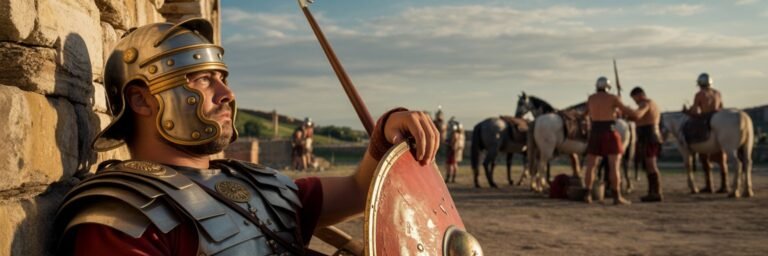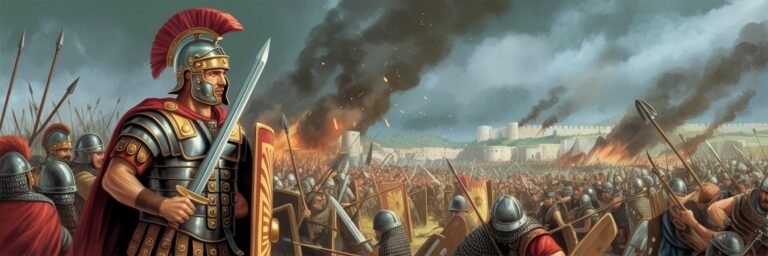INTRODUCTION
The convergence of warfare and religion is as old as civilization itself. From the earliest tribes to intricate societies, human beings have intertwined the divine with the martial, appealing to higher powers for protection, guidance, or simple favor on the battlefield. Drawing on religious rituals and beliefs to fortify combatants or to demoralize enemies has been an intrinsic part of human conflict throughout history. This piece embarks on an exploration of religion and rituals in ancient warfare. It’s a journey through time, across cultures, braving battles where gods intervene and warriors are as much spiritualists as they are soldiers.
HISTORICAL BACKGROUND
The notion of religion as an integral part of warfare has ancient roots. In Mesopotamia, one of the earliest cradles of civilization, we find deities associated with individual cities. When one city fought another, it was also a contest of divine patrons. Assur and Marduk, the chief gods of Assyria and Babylon, frequently clashed symbolically in the escalating conflicts between their people.
The ancient Greeks held a similar view. They believed their pantheon of gods took active roles in human affairs, including battles. Homer’s epic, the Iliad, portrays the gods as key players in the Trojan War, manipulating heroes and altering the course of the fight.
In the late Roman Republic, the practice of taking auspices, interpreting the will of the gods from flight patterns of birds, was a fundamental part of military strategy. And the hallowed concept of ‘bellum justum’, or just war, was intimately tied to the idea of divine sanction.
THEORIES AND INTERPRETATIONS
Scholars have proposed various theories to explain the pervasive presence of religious rituals on the battleground. One common interpretation is psychological: rituals and beliefs provide soldiers with coping mechanisms amidst the chaos and death of war, bolstering morale and nurturing camaraderie.
Anthropologist Scott Atran posited that religion in warfare fosters group solidarity, offers a sense of purpose and moral justification for taking lives. Sociologist Emile Durkheim theorized religious beliefs might even serve to enhance a fighter’s courage, intensifying their will to dominate or offering solace in the prospect of posthumous glory.
MYSTERIES AND CONTROVERSIES
Though largely accepted as a natural phenomenon, the intersection of religion and warfare is not without its controversies. The nature of religion’s role, its extent and significance, is often disputed. Some argue that the religious elements are merely decorative, a sort of veneer applied post-hoc to cloak base, earthly interests in divine disguise.
Others point to cases such as the Viking berserkers, who supposedly fell into trance-like, almost spiritual states before battle, or the Ghost Dance among Native Americans, a mystical ceremony believed to bring about an apocalyptic purification of the earth, proving that religion can have a manifest, transformative role in conflict.
SYMBOLISM AND CULTURAL SIGNIFICANCE
Religious symbols imbued with cultural meaning often played a prominent role in ancient warfare. In ancient Egypt, pharaohs often depicted themselves as Horus, the war god, literally embodying divine power on the battlefield. The Assyrians employed emblems of deities like Assur as battle standards, transforming them from mere symbols into active participants in warfare.
Abstraction can also be seen in how indigenous tribes of North America would paint their bodies with sacred symbols to invoke protection from their gods. And in Hellenistic Greece, entire military formations contributed to the visual spectacle of religious warfare – like the Spartans, with their red cloaks and shields emblazoned with the lambda, symbolizing Lacedaemon, the divine ancestor of their people.
MODERN INVESTIGATIONS
Recent archaeological and historical investigations have enriched our understanding of the practical aspects of religious rituals in ancient warfare. Excavations at the Mayan city of Aguateca yielded an array of ritual paraphernalia suggesting elaborate pre-battle ceremonies. Study of ancient Chinese texts, meanwhile, has outlined detailed rites seeking divine aid in warfare, from interpreting animal entrails to extensive sacrificial rituals.
Anthropological studies on traditional societies still practicing ancient customs, like certain tribes of Papua New Guinea, have given us a unique insight into how these rituals might have functioned in practice and their tangible psychological impact.
LEGACY AND CONCLUSION
The complex relationship between religion and warfare has left an indelible mark on human history. Religion’s knack for uniting groups under a common cause and providing moral justification, whether right or wrong, is a force that has shaped and driven conflict throughout the ages.
While the specifics of rituals and deific involvement have shifted, the core elements continue to reverberate even today. Modern armies still appeal to divine support, with soldiers often taking comfort in personal religious items or observances. The ancient ‘bellum justum’ of the Romans has evolved into contemporary ethical discussions about ‘just war’ theory.
Ultimately, the exploration of religion in ancient warfare not only illuminates the past but tunes us into the ongoing dialogue about the battle, the divine, and the human soul. And in this meeting of spiritual and martial forces, we find a fascinating, if fraught, aspect of humanity—one that continues to shape our understanding of conflict and cooperation in society.


